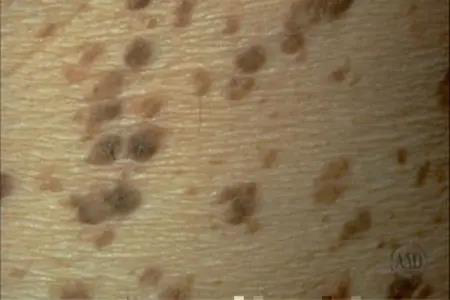Seborrheic Keratoses: Diagnosis and treatment

What is seborrheic keratoses?
Seborrheic keratosis is a common skin growth. It may seem worrisome because it can look like a wart, pre-cancerous skin growth (actinic keratosis), or skin cancer. Despite their appearance, seborrheic keratoses are harmless.
Most people get these growths when they are middle aged or older. Because they begin at a later age and can have a wart-like appearance, seborrheic keratoses are often called the “barnacles of aging.” It’s possible to have just one of these growths, but most people develop several. Some growths may have a warty surface while others look like dabs of warm, brown candle wax on the skin.
Seborrheic keratoses range in color from white to black; however, most are tan or brown.
You can find these harmless growths anywhere on the skin, except the palms and soles. Most often, you’ll see them on the chest, back, head, or neck. Seborrheic keratoses are not contagious.
Who gets seborrheic keratoses?
The people most likely to develop these harmless growths have fair skin and family members who have seborrheic keratoses. These growths also develop in people with medium to dark skin. In dark skin, seborrheic keratoses tend to be small and appear around the eyes.
Some people develop seborrheic keratoses during pregnancy or after estrogen replacement therapy.
Most people develop seborrheic keratoses in middle age or later. The number of seborrheic keratoses tends to increase with age.
Children rarely have seborrheic keratoses.
What causes seborrheic keratoses?
The cause of seborrheic keratoses is unknown. We do know the following:
• Seborrheic keratoses seem to run in families. Some people seem to inherit a tendency to get many of these growths.
• The sun may play a role in causing seborrheic keratoses. Studies suggest that these growths develop on skin that’s gotten lots of sun. Because these growths also develop on skin that’s always covered, more research is needed.
• Seborrheic keratoses are not contagious. These growths may seem to multiply and spread to other parts of the body. What’s really happening is that people get more of these growths as they age.
How do dermatologists diagnose seborrheic keratoses?
In most cases, a dermatologist can tell if your skin growth is a seborrheic keratosis by looking at it. Sometimes, a seborrheic keratosis can look like a skin cancer. If it does, the dermatologist will remove the growth so that it can be looked at under a microscope. This is the only way to tell for sure whether a growth is skin cancer.
How do dermatologists treat seborrheic keratoses?
Because seborrheic keratoses are harmless, they most often do not need treatment. A dermatologist may remove a seborrheic keratosis when it:
• Looks like a skin cancer
• Gets caught on clothing or jewelry
• Becomes irritated easily
• Seems unsightly to a patient
If the growth looks like skin cancer, your dermatologist will likely shave off the growth with a blade or scrape it off. This will allow a specially trained doctor to look for skin cancer cells under a microscope.
Other treatments for seborrheic keratoses include:
• Cryotherapy: The dermatologist applies liquid nitrogen, a very cold liquid, to the growth with a cotton swab or spray gun. This destroys the growth. The seborrheic keratosis tends to fall off within days. Sometimes a blister forms under the seborrheic keratosis and dries into a scab-like crust. The crust will fall off.
• Electrosurgery and curettage: Electrosurgery (electrocautery) involves numbing the growth with an anesthetic and using an electric current to destroy the growth. A scoop-shaped surgical instrument, a curette, is used to scrape off the treated growth. This is the curettage. The patient does not need stitches. There may be a small amount of bleeding. Sometimes the patient needs only electrosurgery or just curettage.
Outcome
After removal of a seborrheic keratosis, the skin may be lighter than the surrounding skin. This usually fades with time. Sometimes it is permanent. Most removed seborrheic keratoses do not return. But a new one may occur elsewhere.
